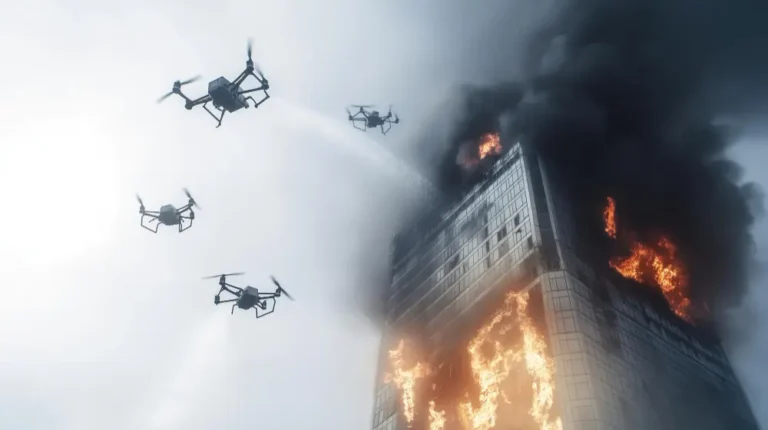How Drones Are Transforming Firefighting and Emergency Response in India
When we think of firefighting, we often imagine courageous firefighters battling roaring flames on the ground. But what if the most powerful firefighting tool doesn’t hold a hose — it flies?
Across India, drones are rapidly becoming one of the most valuable allies for fire and emergency response teams. With their ability to provide real-time aerial insights, detect heat sources, and reach hazardous zones, drones are transforming the way we fight fires and save lives.
A New Perspective: Firefighting from the Sky
During a fire, visibility and time are critical. Traditional methods depend heavily on manual observation and human coordination — both of which can be limited in chaotic fire conditions.
Drones change that equation. Equipped with high-definition cameras, GPS, and live streaming, they offer a complete aerial view of the fire zone within minutes.
Imagine a warehouse fire in Pune or a high-rise blaze in Mumbai. Firefighters on the ground can now see real-time drone footage that highlights where flames are most active, where people are trapped, and which routes are safest for entry. This bird’s-eye perspective helps emergency teams respond faster and more efficiently, reducing risks and saving precious time.
One of the most remarkable drone features is thermal imaging. These cameras detect temperature differences, allowing responders to see through thick smoke and darkness.
In industrial areas like Gujarat, Chennai, and Visakhapatnam — where factories and refineries handle flammable materials — drones can quickly locate the source of heat or potential re-ignition points before they turn disastrous.
Thermal data also plays a vital role in post-fire investigations. Once the flames are out, drones can detect lingering hotspots that could reignite later, ensuring a complete and safe containment of the fire.
Also read: Easy Upgrades to Improve Fire Safety in Your Building.

Enhancing Search and Rescue Operations
When disasters strike, firefighting and search and rescue (SAR) often go hand in hand. Whether it’s a collapsed structure, a forest fire, or flood-related rescue, drones are proving invaluable.
Equipped with infrared sensors and night-vision cameras, drones can cover large areas quickly and locate missing or injured people — even in the dark or in areas inaccessible by road.
For example, during the forest fires in Uttarakhand, drones helped officials track how far flames had spread, guiding firefighting teams to safer and more effective response zones. These drones have literally become the eyes in the sky for emergency teams.
Fast Damage Assessment and Smart Data
After any major fire, assessing damage is crucial for rebuilding and insurance claims. Traditionally, this process took days because entering unstable structures was dangerous.
Drones now make this process faster and safer by capturing high-resolution images and 3D maps of affected areas.
This data not only helps assess the extent of damage but also contributes to fire prevention analytics — showing patterns, risk zones, and how the fire spread.
Cities like Bengaluru, Pune, and Ahmedabad are already integrating drone-based surveys into their smart city fire risk management plans.
Drones in Emergency Medical Response
Drones are also taking on a life-saving medical role. In congested cities or rural regions, they can deliver first aid kits, defibrillators, and essential medical supplies much faster than road vehicles.
During large-scale fire incidents, such as industrial explosions or mass casualty events, drones can quickly drop medical kits to victims and transmit live visuals to hospitals and command centers.
As India’s emergency response systems evolve, AI-powered drones are being explored to assess victims’ conditions, relay health data, and guide medics before they even arrive on-site.
Fire Departments in India Going High-Tech
Across India, several firefighting departments and agencies are embracing drone technology:
- The Delhi Fire Service uses drones for surveillance during large-scale fires.
- The Mumbai Fire Brigade has introduced drone-based thermal imaging systems for rapid detection.
- In Gujarat and Karnataka, drones are being deployed for industrial fire monitoring and post-incident assessments.
Even private organizations are using drones for fire risk monitoring in chemical plants, logistics parks, and high-rise buildings.
The Fire & Security India Expo (FSIE) is actively promoting awareness and innovation in this sector. To explore more about emerging fire safety technologies and industry collaborations, visit fsie.in
Rules, Regulations, and Training in India
While drones are revolutionizing firefighting, proper regulation is essential.
The Directorate General of Civil Aviation (DGCA) oversees drone operations in India under the Drone Rules 2021, allowing emergency agencies to use drones with special permissions for critical operations.
However, success also depends on training skilled drone pilots. Fire departments need personnel who understand both drone operation and emergency coordination. As this technology expands, certified drone training programs will be crucial for ensuring safety and compliance.
If your organization wants to collaborate, demonstrate drone solutions, or learn more about drone applications in fire safety, you can connect directly with the FSIE team here.
Also read: What is building security and why is it important
Environmental Benefits of Drone Use
Apart from their operational value, drones offer significant environmental advantages.
Unlike helicopters or aircraft, drones are electric-powered and emission-free, making them an eco-friendly alternative for aerial surveillance.
They can also monitor air pollution levels, detect toxic gas leaks, and study the ecological impact of major fires — all vital for long-term environmental protection and disaster planning.
In a country like India, where both industrial and forest fires pose environmental threats, drones are becoming a powerful tool in sustainability-driven fire management.
The Future of Drone Firefighting in India
Looking ahead, the possibilities are endless. The next generation of drones is being developed with AI, IoT, and autonomous navigation capabilities.
Some prototypes can even carry small fire extinguishers or foam payloads to tackle fires directly from the air — ideal for high-rise buildings or remote locations.
Integrating drones with real-time data analytics, GIS mapping, and predictive fire models will allow authorities to anticipate risks before they happen, making Indian cities safer and more resilient.
Last word
From detecting hidden fires to saving lives during disasters, drones are redefining what’s possible in firefighting and emergency response.
They bring speed, precision, and safety — three qualities that make all the difference when seconds count.
For India, where rapid urbanization increases fire risks, drone technology is not just innovation — it’s a necessity for a safer, smarter, and more sustainable future.
By integrating drones into national and local emergency systems, we can truly rise above the flames — protecting people, property, and the planet.
